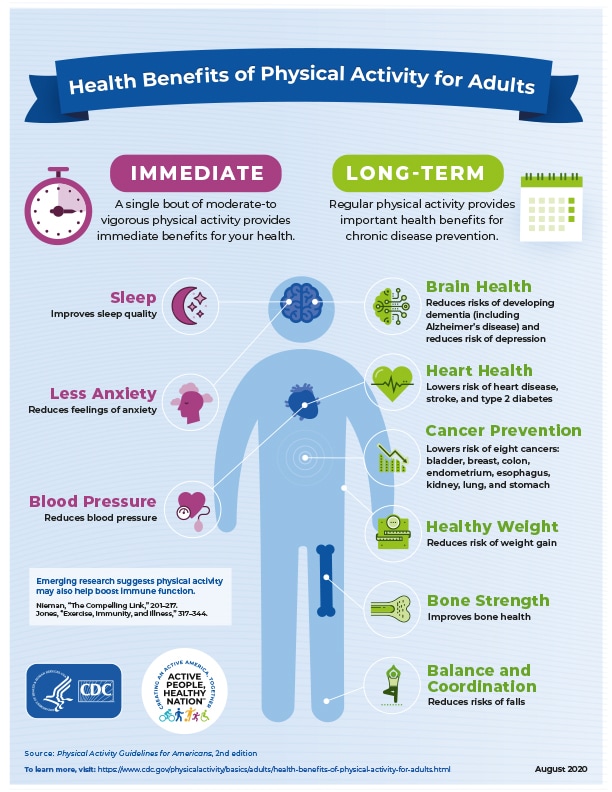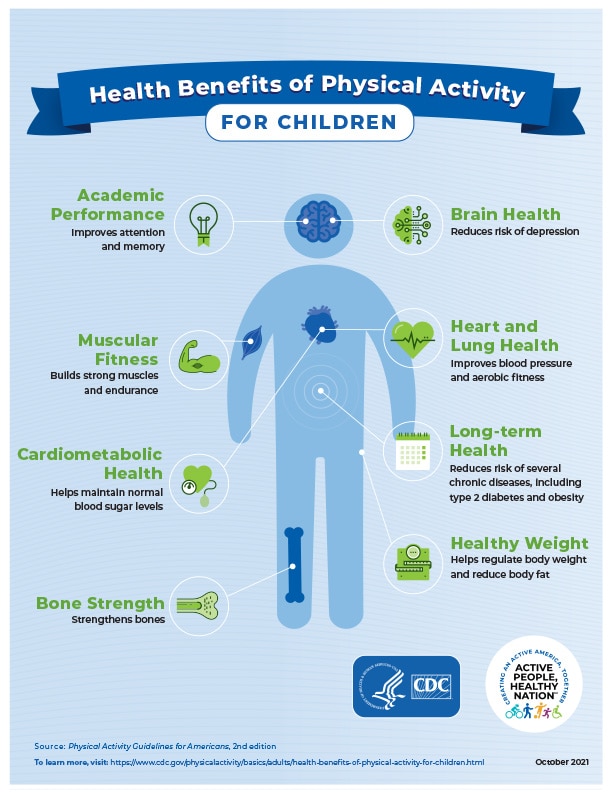Why Should People be Active?
Regular physical activity benefits our health and activity friendly places benefit our communities. However, too few Americans get the recommended amount of physical activity. Only about 1 in 4 adults and 1 in 6 high school students fully meet physical activity guidelines for aerobic and muscle-strengthening activities.
Physical activity benefits health immediately and over time.
For Adults
Immediate Benefits
A single bout of moderate-to vigorous physical activity provides immediate benefits for your health.
- Sleep
– Improves sleep quality - Less Anxiety
– Reduces feelings of anxiety - Blood Pressure
– Reduces blood pressure
Long-term Benefits
Regular physical activity provides important health benefits for chronic disease prevention.
- Brain Health
– Reduces risks of developing dementia (including Alzheimer’s disease) and reduces risk of depression - Heart Health
– Lowers risk of heart disease, stroke, and type 2 diabetes - Cancer Prevention
-Lowers risk of eight cancers: bladder, breast, colon, endometrium, esophagus, kidney, lung, and stomach - Healthy Weight
– Reduces risk of weight gain - Bone Strength
– Improves bone health - Balance and Coordination
– Reduces risks of falls
Emerging research suggests physical activity may also help boost immune function.
For Children
- Academic Performance
– Improves attention and memory - Brain Health
– Reduces risk of depression - Muscular Fitness
– Builds strong muscles and endurance - Heart and Lung Health
– Improves blood pressure and aerobic fitness - Cardiometabolic Health
– Helps maintain normal blood sugar levels - Long-term Health
– Reduces risk of several chronic diseases, including type 2 diabetes and obesity - Bone Strength
– Strengthens bones - Healthy Weight
– Helps regulate body weight and reduce body fat
Physical activity saves lives and dollars.
- Inactivity contributes to 1 in 10 premature deaths.
- About 110,000 deaths could be prevented if US adults increased moderate-to-vigorous physical activity by even 10 minutes per day.
- Inadequate levels of physical activity are associated with $117 billion in annual healthcare costs.
Physical inactivity affects our national security and military readiness.
- Both obesity and low levels of physical fitness increase the risk for injury among active military personnel.
- Nearly 1 in 4 young adults are too heavy to serve in our military.
Communities benefit from an activity friendly design.
- Well-designed communities give people more options to get to the places they need to go by walking, biking, wheelchair rolling, or using public transit.
- Activity friendly communities can improve safety for people who walk, ride bicycles, and drive.
- Activity friendly communities can also help improve the local economy, increase employment opportunities, support neighborhood revitalization, and reduce health care costs.
Resources
- Physical Activity Basics
How physical activity can improve overall health for everyone, no matter age, ability or physical shape. - Adding Physical Activity to Your Life
Ways to increase your physical activity. - Move Your Way
Fun, safe ways to get active! - Adult Physical Inactivity Prevalence Maps by Race/Ethnicity
State maps showing prevalence of physical inactivity and differences by race/ethnicity. - DNPAO Data, Trends and Maps
Interactive database with national and state-level data about the health status and behaviors of Americans as well as environmental or policy supports. - Physical Activity Guidelines for Americans, 2nd edition [PDF-15.2MB]
US Department of Health and Human Services’ guidelines for amounts and types of physical activity needed to maintain or improve overall health and reduce the risk of chronic disease.
Connect with Nutrition, Physical Activity, and Obesity


